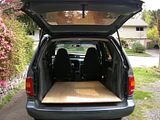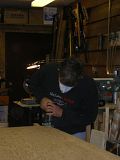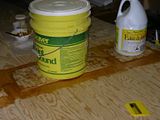[ Home ] [ Nice Canoe 16' ] [ Strip Canoe ] [ Preschool ] [ Puzzles and Impossible Objects ] [ Tent Trailer - A Winter Project for Summer Fun ] [ Geodesic Spheres ] [ Growing Huge Vege Crops with Minimal Watering Worries. ] [ Links ] [ MOT Spot Welder ] [ Styrene Cutter ] [ Rolling Ball Sculptures ]
[ NC16 Epoxy ]
The story behind our 16' Nice Canoe (pirogue).
Back in the early '90's
our family enjoyed a holiday with friends in the Knysna forest area along the
Garden Route of South Africa.
One of the days, we
went with our friends and another family for a day-paddle up the Knysna river.
Ever since, it has been my wish to own my own canoe.
Indigenous
to this region is a bird, the Knysna Turako, or as it is more commonly called,
the "Knysna Loerie". It is this bird that inspired the name of
our canoe.
We have since moved to
Canada, and with the vast amount of "paddleable" water, this yearning
just got stronger and stronger. After web-surfing for many hours through the myriad of websites dedicated to building
one's own boat, I decided to build a 16' "Stitch and Glue" pirogue.
At the beginning of summer
in 2005 I purchased the plans from
Bateau Boats for their "Nice Canoe 16", and got the process started.
My garage was going to become a home workshop. This
page journals the construction of the "Knysna Loerie", and is aimed
at helping those who may be considering, or have already decided to build their
own boat.
I don't profess to be an
expert, either woodworker or sailor, but I built a boat. Without sites
similar to this, and the many forums populated by people who have traveled this
road before me, I believe I may not have had as much fun building, and the end
result would not have been as river-worthy as the Knysna Loerie.
I dedicate this site to my
family, those friends with whom we paddled the Knysna River, the many forum
members who offered advise and support, and all those who have similar sites on
the net which acted as inspiration along the way.
|
Having
purchased the plans from Bateau
Boats, and spent countless hours
researching the process, I decided to use marine ply.( I thought, at the
time, that this boat was going to be the learning experience for future
builds, so did not want to spend more $$$ than absolutely necessary). In
spite of suggestions that the cheapest of exterior plywood would suffice,
I opted to go with marine ply, and Fir was the best price I could find at
the time. |

(Click to Enlarge) |
 (Click to Enlarge) |
The
design is such that the boat is constructed from two 8 x 4 sheets of ply.
(Well, Bateau do have free plans for a 14 footer
called the "Cheap Canoe" which uses 2 sheets. The
NC16 actually needs 2 1/4 sheets once all the butt blocks and seat have
been allowed for). I would suggest anyone using Bateau plans
do purchase
from them, as this allows membership to their forum, which proved to be a
fountain of inspiration and advise which I sorely needed, what with this
being my first experience in boat building and working with epoxy.
OK,
on with the show! Here I have the boards laid out and butted up against
each other to get the lines drawn for cutting. These are all the tools
required to get the lines onto the wood... a tape measure, square, ruler
and a printed copy of the plans from Bateau.
Oh, and a pencil, which is behind my ear !!! |
|
We've all heard the warning, "Measure twice, cut
once". Well, when I was transferring the coordinates from the plan to
the wood, I could hear my late father's words, and probably his father
before him, and his before him, ad nauseum. This is sound advise, as a
little error at this point could evolve into a big, and maybe, costly
error later.
This process, which took me about 1 1/2 hours, played
havoc with my knees and back. The Bateau plans certainly were clear and
precise in what needed to be done.
|

(Click to Enlarge)
|

(Click to Enlarge)
|
Once
all the plotting was completed (and checked, and checked again) I knocked
finishing nails into all the points. |
|
A 16' baseboard did the job of 'joining the dots' to create the smooth
curve needed to mark the cutting lines. Any long, flexible straightedge
would work, conduit, wood strip, etc. |

(Click to Enlarge)
|

(Click to Enlarge)
|
At
last, after working on the floor for a little over 'too long', I moved
into the garage, which was to be my home for the next 6 weeks or so. Not
that I was there 24/7, but I did sneak in as often as my other domestic
duties would allow. In order to cut as close and smoothly along the lines
as possible, it is suggested to use a circular saw. Since I do not own a
portable hand held saw (yet), I used my jig saw, and managed to cut close
enough to the lines to stay within the generous tolerances allowed with
the "stitch and glue" method of construction. |
|
With all the cutting finished, I re-assembled the pieces to see the best
grain pattern. Not much choice, but I wanted to keep the inside unpainted,
so needed to have the board orientated correctly. This is the
"outside up", and I then butted the front and back together and
connected with duct tape. |

(Click to Enlarge)
|

(Click to Enlarge)
|
I
flipped the taped pieces over, and not visible in the photo (because it's
underneath) is a length of duct tape running the width of all of them.
This will act as a hinge a little later. |
|
My First Encounter With Epoxy.
In hindsight, this was no big deal, but I
was pretty anxious about working with epoxy for the first time. The butt
blocks needed to be fitted. An epoxy glue is mixed using epoxy resin and
wood flour. There are countless sites and forums dedicated to the use of
epoxy. Again I spent hours surfing the net, and eventually, suffering from
information-overload, Just Did It !!!
|

(Click to Enlarge)
|

(Click to Enlarge)
|
Well,
with all the different opinions on 'how to' and 'when to' and sometimes
even 'why to' I was surprised at how easy the process actually is.
The panels and butt blocks are first coated with a layer of plain epoxy,
and then the wood flour glue mixture is applied. The glue needs to be the
consistency of ketchup. Again checking on alignment and grain etc.
the blocks are waited down and left to cure. This should be left overnight,
but the recommendation is 24 hours. I found the blocks tended to slide
around on the glue, so had to check the positioning regularly until the
epoxy gelled enough to stay in one place... where I wanted them. |
|
Once set, a cross piece is fitted and the "hinge" brought into
play. The sides are folded up and I put screws through, into the cross
piece. I small point, but cut the ends of the cross piece at the angle of
the side panel. Later on, there is a lot of pressure at this point, and
square ends dent the panel. Go on, ask me how I know !! |

(Click to Enlarge)
|

(Click to Enlarge)
|
The
stems are then brought together and clamped in place. (This was when I realized
the cross piece needed to be at the angle). In traditional Stitch and
Glue, holes are drilled along the edges of the panels and they are
"stitched" together with copper wire or electric cable ties.
Since there is not a lot of tension in the Nice Canoe construction, I went
with the suggestion that duct tape will work just as well. |
|
I tacked the panels together with the tape until I was happy that all the
pieces were in the right place. Here, it's a good practice to rotate from
quarter to quarter. Starting in the middle, tape left front, right front,
left back, right back, left front, right front... you get the picture?
This will ensure the panels line up as true and symmetrical as possible,
or at least as good as your cutting allows. |

(Click to Enlarge)
|

(Click to Enlarge)
|
When
all the tacking is done, the joints were closed off with duct tape. This,
while holding the panels together, also prevents epoxy glue from oozing
out during the filleting process to follow. |
|
Take care when taping on the hinge, to make it as tight as possible. With
Stitch and Glue, one wants a small gap between panels, but only about 10mm
max they say, (still trying to figure out who they are, but
anyhow). I misjudged the stretch of the duct tape, and was presented with
this gap amidships. It is not recommended to have wood butting up against
wood. It's the epoxy and glass tape which gives the boat strength and
reinforcement, and wood against wood does not allow flexibility, and
causes stress points at the joins. |

(Click to Enlarge)
|

(Click to Enlarge)
|
The
beauty of building your own boat, and from wood to boot, is that there are
guidelines, albeit, but no rules per se. Problems are easy to solve, and I
needed my strap clamp, a bit more tape... |
|
... and voila! My side joints were fixed. |

(Click to Enlarge)
|
[ NC16 Epoxy ]









